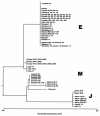Global identification of three major genotypes of varicella-zoster virus: longitudinal clustering and strategies for genotyping
- PMID: 15254207
- PMCID: PMC446121
- DOI: 10.1128/JVI.78.15.8349-8358.2004
Global identification of three major genotypes of varicella-zoster virus: longitudinal clustering and strategies for genotyping
Abstract
By analysis of a single, variable, and short DNA sequence of 447 bp located within open reading frame 22 (ORF22), we discriminated three major varicella-zoster virus (VZV) genotypes. VZV isolates from all six inhabited continents that showed nearly complete homology to ORF22 of the European reference strain Dumas were assigned to the European (E) genotype. All Japanese isolates, defined as the Japanese (J) genotype, were identical in the respective genomic region and proved the most divergent from the E strains, carrying four distinct variations. The remaining isolates carried a combination of E- and J-specific variations in the target sequence and thus were collectively termed the mosaic (M) genotype. Three hundred twenty-six isolates collected in 27 countries were genotyped. A distinctive longitudinal distribution of VZV genotypes supports this approach. Among 111 isolates collected from European patients, 96.4% were genotype E. Consistent with this observation, approximately 80% of the VZV strains from the United States were also genotype E. Similarly, genotype E viruses were dominant in the Asian part of Russia and in eastern Australia. M genotype viruses were strongly dominant in tropical regions of Africa, Indochina, and Central America, and they were common in western Australia. However, genotype M viruses were also identified as a minority in several countries worldwide. Two major intertypic variations of genotype M strains were identified, suggesting that the M genotype can be further differentiated into subgenotypes. These data highlight the direction for future VZV genotyping efforts. This approach provides the first simple genotyping method for VZV strains in clinical samples.
Figures




Similar articles
-
Identification of five major and two minor genotypes of varicella-zoster virus strains: a practical two-amplicon approach used to genotype clinical isolates in Australia and New Zealand.J Virol. 2007 Dec;81(23):12758-65. doi: 10.1128/JVI.01145-07. Epub 2007 Sep 26. J Virol. 2007. PMID: 17898056 Free PMC article.
-
Toward universal varicella-zoster virus (VZV) genotyping: diversity of VZV strains from France and Spain.J Clin Microbiol. 2007 Feb;45(2):559-63. doi: 10.1128/JCM.01738-06. Epub 2006 Nov 29. J Clin Microbiol. 2007. PMID: 17135433 Free PMC article.
-
Distribution of varicella-zoster virus (VZV) wild-type genotypes in northern and southern Europe: evidence for high conservation of circulating genotypes.Virology. 2009 Jan 20;383(2):216-25. doi: 10.1016/j.virol.2008.10.026. Epub 2008 Nov 20. Virology. 2009. PMID: 19019403
-
Varicella zoster virus: out of Africa and into the research laboratory.Herpes. 2006 Aug;13(2):32-6. Herpes. 2006. PMID: 16895651 Review.
-
Evolution and world-wide distribution of varicella-zoster virus clades.Infect Genet Evol. 2011 Jan;11(1):1-10. doi: 10.1016/j.meegid.2010.08.014. Epub 2010 Sep 15. Infect Genet Evol. 2011. PMID: 20817040 Review.
Cited by
-
Identification of five major and two minor genotypes of varicella-zoster virus strains: a practical two-amplicon approach used to genotype clinical isolates in Australia and New Zealand.J Virol. 2007 Dec;81(23):12758-65. doi: 10.1128/JVI.01145-07. Epub 2007 Sep 26. J Virol. 2007. PMID: 17898056 Free PMC article.
-
Monitoring prevalence of varicella-zoster virus clades in Germany.Med Microbiol Immunol. 2011 May;200(2):99-107. doi: 10.1007/s00430-010-0178-6. Epub 2010 Oct 31. Med Microbiol Immunol. 2011. PMID: 21072536
-
A genome-wide comparative evolutionary analysis of herpes simplex virus type 1 and varicella zoster virus.PLoS One. 2011;6(7):e22527. doi: 10.1371/journal.pone.0022527. Epub 2011 Jul 25. PLoS One. 2011. PMID: 21799886 Free PMC article.
-
Analysis of equid herpesvirus 1 strain variation reveals a point mutation of the DNA polymerase strongly associated with neuropathogenic versus nonneuropathogenic disease outbreaks.J Virol. 2006 Apr;80(8):4047-60. doi: 10.1128/JVI.80.8.4047-4060.2006. J Virol. 2006. PMID: 16571821 Free PMC article.
-
Genetic profile of an Oka varicella vaccine virus variant isolated from an infant with zoster.J Clin Microbiol. 2004 Dec;42(12):5604-8. doi: 10.1128/JCM.42.12.5604-5608.2004. J Clin Microbiol. 2004. PMID: 15583288 Free PMC article.
References
-
- Adams, S. G., D. E. Dohner, and L. D. Gelb. 1989. Restriction fragment differences between the genomes of the Oka varicella vaccine virus and American wild-type varicella-zoster virus. J. Med. Virol. 29:38-45. - PubMed
-
- Arvin, A. M., C. M. Koropchak, and A. E. Wittek. 1983. Immunologic evidence of reinfection with varicella-zoster virus. J. Infect. Dis. 148:200-205. - PubMed
-
- Boppana, S. B., L. B. Rivera, K. B. Fowler, M. Mach, and W. J. Britt. 2001. Intrauterine transmission of cytomegalovirus to infants of women with preconceptional immunity. N. Engl. J. Med. 344:1366-1371. - PubMed
Publication types
MeSH terms
Substances
LinkOut - more resources
Full Text Sources
Other Literature Sources

